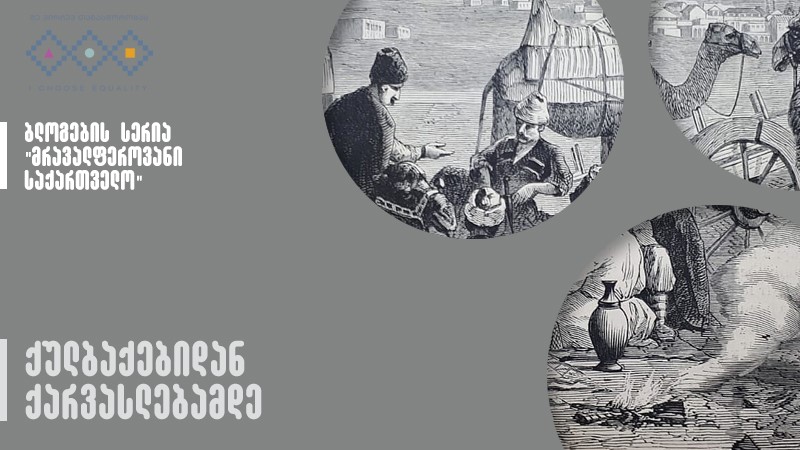Author: Sulkhan Saladze
Since the ancient times, colourful squares in Tbilisi attracted many people.
These squares were always a place to meet for different cultures, for people speaking different languages. Their majority were traders. It didn’t matter which ethnic group they belonged to or which religion they followed. It is safe to say that history of Old Tbilisi squares is as long and interesting as that of Tbilisi.
This story is not about Tbilisi squares per se but rather, about markets, caravanserais, Kulbaks and Fundukis and they could all be found at the squares of Old Tbilisi.
Houses and places designated for trade in Old Tbilisi were called „Sapardule“, which was replaced by Persian „Kulbaki“ in 10th-11th centuries. Kulbaki is a place for selling goods, a store, while places that were designated for trade, where traders came together where known as „squares“. Places where traders that had just arrived from foreign countries and where they kept their goods also had their names. These places were called „Pondokioni“ (from Greek), while later they were referred to as „Funduki“. Beginning from the 12th century, another Persian word – Caravanserais was introduced, which gradually replaced Funduki. Caravanserai literally means a palace for caravan.
Craftsmanship was quickly developing next to trade. At different times, associations of craftsman were referred to by different names. First, they used Ofikali, which was later replaced by Tabuni. In Tbilisi, for a long time an Arabian word „Asnapi“ was used to refer to a group of people who were skilled in the same craft. Lastly, „Hamkari“ from Persian was introduced.
Appearance of caravan’s palaces clearly confirms interest of foreign traders in Tbilisi. For example, in the 1660s, missionary Serafino Melikokanel wrote the following about Tbilisi – „Traders from Persia, Aleppo, Smyrna, Constantinople and from all over Georgia continue to meet in Tbilisi“...
Similar to Melikokanel, French gem trader Jean Chardin, who visited Tbilisi in 1673, wrote the following – „Not a single corner of the world has as many foreigners as this place. They are involved in a big trade here.“ 1673 was the time when King of Kartli Vakhtang V was persuading Chardin that there was no better road than Tbilisi for European traders that were travelling to Persia and India.
Even though Tbilisi was more actively involved in trade with Islamic countries and it was most often visited by caravans from Tabriz, Arzrum, Ganja, Yerevan, Shamakhi, Constantinople or Smyrna, the city was also familiar with Europe. Another French traveller Charles Peisonel, who visited Tbilisi in mid-18th century wrote that golden and silver threads mixed with silk had been brought from the Netherlands. In the late 18th century, broadcloth and sugar was exported in Tbilisi from Amsterdam, while silk fabrics were exported from Venice.
Markets were one of the main areas for trade in Tbilisi. They were mostly located at squares. There were „Upper markets“, „Lower markets“, „Meidan markets“ or „Rastabazar“ (the same as „Tatar’s Square“ market) and „Chorusbazar“. The city also had a slew of markets that didn’t occupy squares but rather, were located along the streets. In that respect, there were „Mekvabeebi Market“, „Kharazkhani Market“ and „Goldsmith Market“, etc. in Tbilisi.
Traders and caravans from foreign countries met not just at markets or squares in Tbilisi. There were also caravanserais. According to Vakhushti Batonishvili, in the first half of the 19th century, there were four primary caravanserais in Tbilisi – „Tbileli’s“, „Meliki’s“, „Bezhani’s“ and „King’s Funduki“.
Beginning from the 19th century, number of caravanserais grew bigger, trade increased, so did markets. All travellers that visited 19th-century Tbilisi especially emphasized markets and caravanserais of the city in their records.
A female traveller of Austrian origin, Frederika von Freygang, who visited Tbilisi in 1811, wrote about multitude of Persian, Turkish and Armenian traders in caravanserais. French botanic Charles Paulus Belanger, who visited Tbilisi in 1825, especially underlined a large caravanserai of Armenian Patriarch Nerses and adds that Orthodox, Muslim and Armenian people in Tbilisi have their own churches, temples and mosques.
Records of Alexandre Dumas about commercial streets of old Tbilisi are especially noteworthy. According to the French writer – „Certain types of goods are sold at every street. I don’t know what they call these streets in Tbilisi but if you ask me, they should be named after goldsmiths, hatters, gun-smiths, fruit-growers, blacksmiths, tailors, Khazars, shoe-makers or slipper-makers. According to the rules of Tbilisi industry where Tatars, Persians, Armenians and Georgians are involved, a boot-maker will not make any other shoe or slippers, while a slipper-maker only makes slippers.“ When speaking about commercial streets of Tbilisi, he said that foreigners will never be bored by walking there and he himself visited markets of the city almost every day.
Despite all these things, many unique characteristics of Old Tbilisi were forgotten as the time went by; only stories remain about the city of Tbilisi, which was the most colourful and diverse place in the entire East with its Kulbaks, squares, Fundukis, caravanserais, merchants and craftsmen.
The document has been prepared with the support of I Choose Equality campaign, implemented within the Council of Europe project “Fight against discrimination, hate crimes and hate speech in Georgia”. Opinions expressed in this document are the sole responsibility of the author and do not necessarily represent the official position of the Council of Europe.




